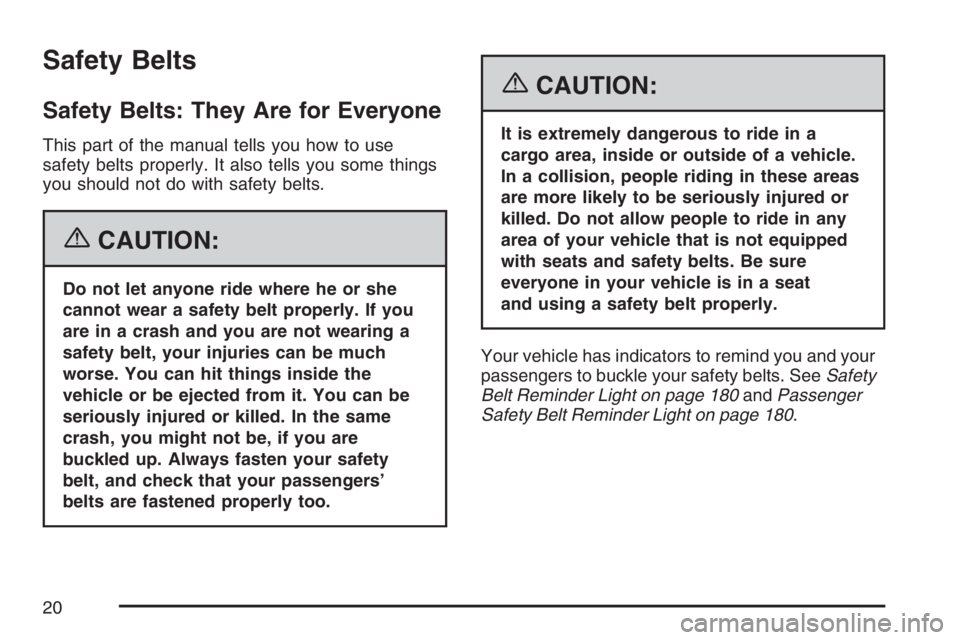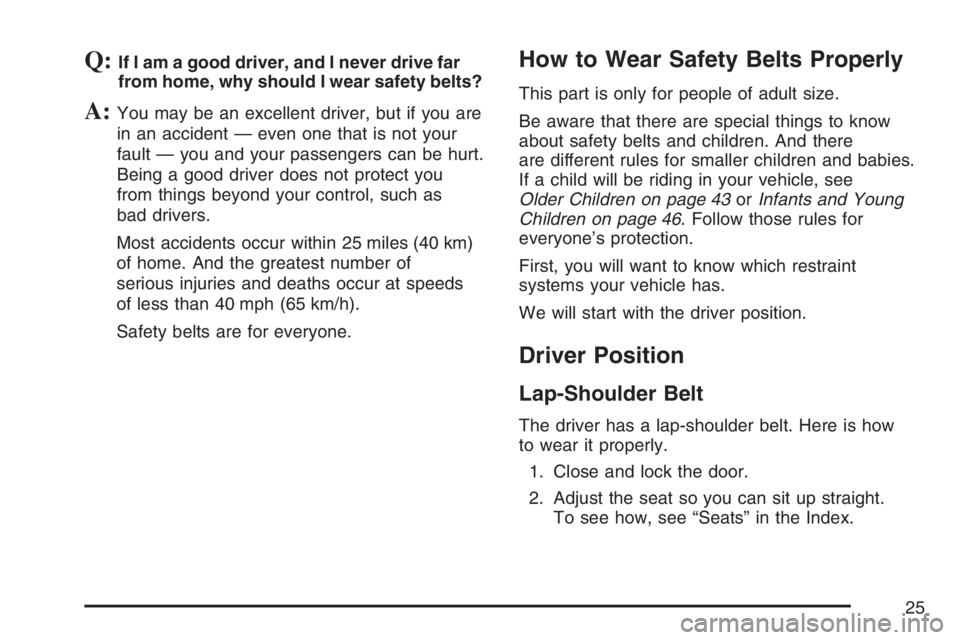Page 12 of 492
Reclining Seatbacks
Manual Reclining Seatbacks
{CAUTION:
You can lose control of the vehicle if
you try to adjust a manual driver’s seat
while the vehicle is moving. The sudden
movement could startle and confuse you,
or make you push a pedal when you do
not want to. Adjust the driver’s seat only
when the vehicle is not moving.
{CAUTION:
If the seatback is not locked, it could
move forward in a sudden stop or crash.
That could cause injury to the person
sitting there. Always push and pull on
the seatback to be sure it is locked.If your seats have manual reclining seatbacks,
the lever used to operate them is located on the
outboard side of the seat(s).
To recline the seatback, do the following:
1. Lift the recline lever.
2. Move the seatback to the desired position,
then release the lever to lock the seatback
in place.
3. Push and pull on the seatback to make sure
it is locked.
12
Page 13 of 492
To return the seatback to an upright position, do
the following:
1. Lift the lever fully without applying pressure to
the seatback and the seatback will return to
the upright position.
2. Push and pull on the seatback to make sure it
is locked.Power Reclining Seatbacks
If the seats have power
reclining seatbacks, use
the vertical power
seat control located on
the outboard side of
the seat.
To recline the seatback, press the control
toward the rear of the vehicle.
To raise the seatback, press the control
toward the front of the vehicle.
13
Page 15 of 492
Head Restraints
Your front seats may have adjustable head
restraints. If your vehicle has rear seats, they
may have adjustable head restraints.
Adjust the head restraint so that the top of the
restraint is at the same height as the top of
the occupant’s head. This position reduces the
chance of a neck injury in a crash.Pull up on the head
restraint to raise it. To
lower the head restraint,
press the button located
on top of the seatback
and push down on the
head restraint.
15
Page 16 of 492
Seatback Latches
Your vehicle may have front seatbacks that fold
forward for easy access to the rear seats or
the storage area behind the seats.
To fold the seatback
forward, push the lever
on the side of the seat
rearward and pull the
seatback forward.{CAUTION:
If the seatback is not locked, it could
move forward in a sudden stop or crash.
That could cause injury to the person
sitting there. Always push and pull on the
seatback to be sure it is locked.
To return the seatback to the upright position,
push the seatback all the way back until it latches.
If the seatback was reclined before being folded
forward, it will return to the reclined position.
16
Page 17 of 492
Rear Seats
Rear Seat Operation (Extended Cab)
If your vehicle has an
extended cab, there may
be forward folding seats
in the rear area.
To fold the rear seat cushion(s) from the stored
position to the sitting position, pull the front of the
seat cushion down completely.
The rear seat storage compartments must be
closed before folding the seat down. SeeRear
Storage Area on page 151.To store the seat, do the following:
Notice:Folding a rear seat with the safety
belts still fastened may cause damage to the
seat or the safety belts. Always unbuckle
the safety belts and return them to their normal
stowed position before folding a rear seat.
1. Secure the safety belt buckle to the inboard side
of the seat with the hook and loop fastener (A),
so that it does not move when not in use.
2. Push the entire seat up until it is �ush with the
trim panel.
17
Page 20 of 492

Safety Belts
Safety Belts: They Are for Everyone
This part of the manual tells you how to use
safety belts properly. It also tells you some things
you should not do with safety belts.
{CAUTION:
Do not let anyone ride where he or she
cannot wear a safety belt properly. If you
are in a crash and you are not wearing a
safety belt, your injuries can be much
worse. You can hit things inside the
vehicle or be ejected from it. You can be
seriously injured or killed. In the same
crash, you might not be, if you are
buckled up. Always fasten your safety
belt, and check that your passengers’
belts are fastened properly too.
{CAUTION:
It is extremely dangerous to ride in a
cargo area, inside or outside of a vehicle.
In a collision, people riding in these areas
are more likely to be seriously injured or
killed. Do not allow people to ride in any
area of your vehicle that is not equipped
with seats and safety belts. Be sure
everyone in your vehicle is in a seat
and using a safety belt properly.
Your vehicle has indicators to remind you and your
passengers to buckle your safety belts. SeeSafety
Belt Reminder Light on page 180andPassenger
Safety Belt Reminder Light on page 180.
20
Page 25 of 492

Q:If I am a good driver, and I never drive far
from home, why should I wear safety belts?
A:You may be an excellent driver, but if you are
in an accident — even one that is not your
fault — you and your passengers can be hurt.
Being a good driver does not protect you
from things beyond your control, such as
bad drivers.
Most accidents occur within 25 miles (40 km)
of home. And the greatest number of
serious injuries and deaths occur at speeds
of less than 40 mph (65 km/h).
Safety belts are for everyone.
How to Wear Safety Belts Properly
This part is only for people of adult size.
Be aware that there are special things to know
about safety belts and children. And there
are different rules for smaller children and babies.
If a child will be riding in your vehicle, see
Older Children on page 43orInfants and Young
Children on page 46. Follow those rules for
everyone’s protection.
First, you will want to know which restraint
systems your vehicle has.
We will start with the driver position.
Driver Position
Lap-Shoulder Belt
The driver has a lap-shoulder belt. Here is how
to wear it properly.
1. Close and lock the door.
2. Adjust the seat so you can sit up straight.
To see how, see “Seats” in the Index.
25
Page 39 of 492
To unlatch the belt, just push the button on the
buckle. For outboard seating positions, when
the safety belt is not in use, slide the latch plate
up the safety belt webbing. The latch plate should
rest on the stitching on the safety belt, near the
guide loop on the side wall.
Rear Safety Belt Comfort Guides
Your vehicle may have rear shoulder belt comfort
guides for the rear outside positions.
Rear shoulder belt comfort guides may provide
added safety belt comfort for older children who
have outgrown booster seats and for some adults.
When installed on a shoulder belt, the comfort guide
positions the belt away from the neck and head.
Here is how to install a comfort guide to the
shoulder belt.
1. Slide the guide off of its storage clip located
between the interior body and the seatback.
39